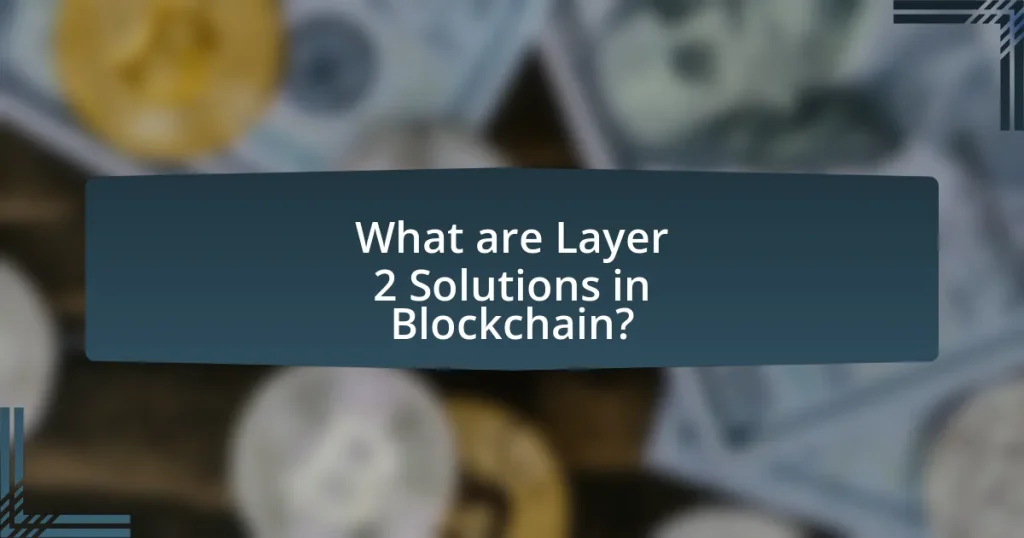Layer 2 solutions are protocols designed to enhance the scalability and transaction throughput of existing blockchain networks by processing transactions off the main blockchain. This article explores various types of Layer 2 solutions, including state channels, sidechains, and rollups, detailing how they improve transaction speed, reduce costs, and alleviate congestion on primary blockchains like Bitcoin and Ethereum. It also addresses the necessity of these solutions for overcoming scalability challenges, the security implications they carry, and their potential applications across different industries, including finance, gaming, and healthcare. Additionally, the article discusses the challenges and best practices associated with implementing Layer 2 solutions, emphasizing the importance of security and interoperability in optimizing blockchain performance.

What are Layer 2 Solutions in Blockchain?
Layer 2 solutions in blockchain are protocols built on top of existing blockchain networks to enhance scalability and transaction throughput. These solutions, such as the Lightning Network for Bitcoin and Optimistic Rollups for Ethereum, enable faster and cheaper transactions by processing them off the main blockchain while still leveraging its security. By reducing congestion on the primary chain, Layer 2 solutions significantly improve the overall efficiency and usability of blockchain technology, addressing the limitations of transaction speed and cost associated with Layer 1 networks.
How do Layer 2 Solutions enhance blockchain scalability?
Layer 2 solutions enhance blockchain scalability by processing transactions off the main blockchain, thereby reducing congestion and increasing throughput. These solutions, such as state channels and rollups, allow for a greater number of transactions to be executed simultaneously without burdening the base layer. For instance, Ethereum’s rollups can handle thousands of transactions per second compared to the base layer’s limitations, significantly improving scalability. This off-chain processing not only alleviates network congestion but also lowers transaction fees, making blockchain technology more efficient and accessible for users.
What are the key features of Layer 2 Solutions?
Layer 2 solutions are designed to enhance blockchain scalability by enabling faster transactions and reducing congestion on the main blockchain. Key features include off-chain processing, which allows transactions to occur outside the main chain, thereby increasing throughput. Additionally, Layer 2 solutions often utilize state channels or rollups to bundle multiple transactions into a single one, further optimizing efficiency. They also maintain security by leveraging the underlying blockchain’s consensus mechanism, ensuring that transactions remain secure and verifiable. These features collectively contribute to improved scalability and user experience in blockchain networks.
How do Layer 2 Solutions differ from Layer 1 solutions?
Layer 2 solutions differ from Layer 1 solutions primarily in their operational layer within blockchain architecture. Layer 1 solutions refer to the base blockchain protocol, such as Bitcoin or Ethereum, which handles all transactions and smart contracts directly on the main chain. In contrast, Layer 2 solutions operate on top of Layer 1, facilitating transactions off the main chain to improve scalability and reduce congestion. For example, technologies like the Lightning Network for Bitcoin and Optimistic Rollups for Ethereum allow for faster and cheaper transactions by processing them off-chain while still leveraging the security of the underlying Layer 1 blockchain. This distinction is crucial as it enables Layer 2 solutions to enhance throughput and efficiency without altering the foundational Layer 1 protocols.
Why are Layer 2 Solutions necessary for blockchain networks?
Layer 2 solutions are necessary for blockchain networks to enhance scalability and improve transaction throughput. Traditional blockchain networks, like Bitcoin and Ethereum, face limitations in processing speed and transaction volume due to their consensus mechanisms and block size constraints. For instance, Bitcoin can handle approximately 7 transactions per second, while Ethereum processes around 30 transactions per second. Layer 2 solutions, such as the Lightning Network for Bitcoin and Optimistic Rollups for Ethereum, enable off-chain transactions that reduce the load on the main blockchain. This approach allows for faster and cheaper transactions, addressing the scalability issues that hinder widespread adoption and usability of blockchain technology.
What challenges do blockchain networks face without Layer 2 Solutions?
Blockchain networks face significant challenges without Layer 2 solutions, primarily including scalability limitations, high transaction fees, and slow confirmation times. Scalability issues arise because most blockchain networks, like Bitcoin and Ethereum, can only process a limited number of transactions per second, leading to congestion during peak usage. For instance, Bitcoin can handle approximately 7 transactions per second, while Ethereum processes around 30, which is insufficient for widespread adoption.
High transaction fees occur as users compete to have their transactions prioritized during times of network congestion, making it economically unfeasible for smaller transactions. During the Ethereum network’s peak usage in 2021, average transaction fees soared to over $50, deterring users from engaging with the network.
Slow confirmation times further exacerbate these issues, as users may experience delays in transaction finality, which can take several minutes or longer, depending on network load. This latency undermines the user experience and limits the potential for real-time applications. Therefore, without Layer 2 solutions, blockchain networks struggle to maintain efficiency, affordability, and user satisfaction.
How do Layer 2 Solutions address transaction speed and cost issues?
Layer 2 solutions enhance transaction speed and reduce costs by processing transactions off the main blockchain, thereby alleviating congestion. These solutions, such as state channels and rollups, allow multiple transactions to be bundled together before being settled on the main chain, significantly decreasing the load and associated fees. For instance, Ethereum’s Optimistic Rollups can increase throughput to thousands of transactions per second while lowering costs by up to 90% compared to on-chain transactions. This efficiency is achieved by minimizing the data that needs to be recorded on the main blockchain, thus optimizing resource usage and improving overall scalability.

What are the different types of Layer 2 Solutions?
The different types of Layer 2 solutions include state channels, sidechains, rollups, and plasma. State channels allow participants to conduct transactions off-chain and only settle the final state on-chain, significantly reducing congestion. Sidechains operate independently of the main blockchain, enabling assets to be transferred between chains while maintaining their own consensus mechanisms. Rollups bundle multiple transactions into a single one, which is then processed on-chain, enhancing throughput and reducing costs. Plasma creates smaller child chains that can process transactions independently, periodically submitting proofs to the main chain for security. Each of these solutions addresses scalability challenges by optimizing transaction processing and reducing the load on the primary blockchain.
How do state channels work in Layer 2 Solutions?
State channels in Layer 2 solutions enable off-chain transactions between participants, allowing them to interact without congesting the main blockchain. Participants open a state channel by creating a multi-signature wallet and locking a certain amount of cryptocurrency, which serves as collateral. They can then conduct numerous transactions off-chain, updating their balances and states without broadcasting each transaction to the main blockchain. Once the participants finalize their interactions, they submit the final state to the blockchain, which reflects the net result of all transactions. This mechanism significantly reduces transaction fees and increases throughput, as only the opening and closing transactions are recorded on-chain, minimizing the load on the main blockchain.
What are the advantages of using state channels?
State channels offer significant advantages for blockchain scalability, primarily by enabling off-chain transactions that reduce congestion on the main blockchain. This mechanism allows participants to conduct multiple transactions without needing to record each one on the blockchain, thus minimizing fees and increasing transaction speed. For instance, state channels can facilitate instant payments and interactions, as seen in the Lightning Network for Bitcoin, which allows thousands of transactions per second compared to the main chain’s limitations. Additionally, state channels enhance privacy since only the final state is recorded on the blockchain, keeping intermediate transactions confidential. This combination of increased efficiency, reduced costs, and improved privacy makes state channels a compelling solution for scaling blockchain networks.
What limitations do state channels have?
State channels have several limitations, including the requirement for both parties to be online to initiate and finalize transactions. This necessity can hinder usability, especially in scenarios where one party may be unavailable. Additionally, state channels are primarily effective for specific types of transactions, such as those involving frequent interactions between a limited number of participants, which restricts their applicability to broader use cases. Furthermore, the complexity of setting up and managing state channels can deter users who lack technical expertise, limiting their adoption. Lastly, state channels do not provide a solution for disputes that arise outside the channel, as they rely on the assumption that both parties will act honestly.
What role do sidechains play in Layer 2 Solutions?
Sidechains serve as a crucial component in Layer 2 solutions by enabling the transfer of assets and data between different blockchains while alleviating congestion on the main chain. They allow for faster transactions and lower fees by processing operations off the main blockchain, thus enhancing scalability. For instance, the Liquid Network, a Bitcoin sidechain, facilitates quicker transactions and confidential transfers, demonstrating how sidechains can effectively reduce the load on the primary blockchain while maintaining security and interoperability.
How do sidechains improve scalability?
Sidechains improve scalability by allowing transactions to occur off the main blockchain, thereby reducing congestion and increasing throughput. This separation enables the main chain to process fewer transactions directly, which enhances its performance and speed. For instance, sidechains can handle specific types of transactions or smart contracts, allowing the main blockchain to focus on its core functionalities. As a result, the overall network can support a higher volume of transactions simultaneously, leading to improved scalability.
What are the security implications of using sidechains?
Using sidechains introduces several security implications, primarily related to the potential for reduced security compared to the main blockchain. Sidechains operate independently, which means they may not benefit from the same level of decentralization and consensus mechanisms that secure the primary blockchain. This independence can lead to vulnerabilities, such as the risk of a sidechain being compromised if it has a smaller network of validators or miners, making it more susceptible to attacks like double-spending or 51% attacks.
Additionally, the process of transferring assets between the main blockchain and a sidechain can create security risks, particularly if the mechanisms for locking and unlocking assets are not robust. If these mechanisms are exploited, it could result in the loss of funds or unauthorized access to assets. Furthermore, the reliance on smart contracts for operations on sidechains can introduce additional vulnerabilities if the contracts are not thoroughly audited or if they contain bugs.
In summary, while sidechains can enhance scalability, they also pose significant security risks that must be carefully managed to protect users and assets.
What are rollups and how do they function?
Rollups are Layer 2 scaling solutions that aggregate multiple transactions into a single batch, which is then processed on the main blockchain. They function by executing transactions off-chain and periodically submitting the compressed data back to the main chain, significantly reducing congestion and increasing throughput. For instance, Optimistic Rollups assume transactions are valid by default and only check for fraud when challenged, while zk-Rollups use zero-knowledge proofs to ensure transaction validity without revealing underlying data. This mechanism allows for greater scalability, as evidenced by Ethereum’s implementation of rollups, which can increase transaction capacity by up to 100 times compared to processing each transaction individually on-chain.
What are the differences between optimistic and zk-rollups?
Optimistic rollups and zk-rollups differ primarily in their approach to transaction validation. Optimistic rollups assume transactions are valid and only challenge them when fraud is suspected, relying on a dispute resolution mechanism that can take up to a week. In contrast, zk-rollups use zero-knowledge proofs to validate transactions off-chain, ensuring immediate finality and security without the need for a challenge period. This fundamental difference affects their scalability, with zk-rollups generally offering faster transaction finality and stronger security guarantees compared to optimistic rollups, which may face delays due to the fraud-proof process.
How do rollups impact transaction throughput?
Rollups significantly enhance transaction throughput by aggregating multiple transactions into a single batch before submitting them to the main blockchain. This batching process reduces the amount of data that needs to be processed on-chain, allowing for a higher volume of transactions to be confirmed in a shorter time frame. For instance, Ethereum’s Optimistic Rollups can increase throughput by up to 100 times compared to processing transactions directly on the Ethereum mainnet, as they minimize the computational load and optimize data storage. This efficiency not only accelerates transaction speeds but also lowers fees, making blockchain networks more scalable and accessible for users.

What are the benefits of implementing Layer 2 Solutions?
Implementing Layer 2 solutions significantly enhances blockchain scalability by increasing transaction throughput and reducing latency. These solutions, such as state channels and rollups, allow for off-chain processing of transactions, which alleviates congestion on the main blockchain. For instance, Ethereum’s rollups can process thousands of transactions per second, compared to the main chain’s limit of around 30 transactions per second. This increased capacity not only improves user experience through faster transaction confirmations but also lowers transaction fees, making blockchain technology more accessible. Additionally, Layer 2 solutions maintain the security of the underlying blockchain, ensuring that the integrity of transactions is preserved while optimizing performance.
How do Layer 2 Solutions improve user experience?
Layer 2 solutions improve user experience by significantly increasing transaction speed and reducing costs on blockchain networks. These solutions, such as state channels and rollups, enable off-chain processing, which alleviates congestion on the main blockchain. For instance, Ethereum’s layer 2 solutions can handle thousands of transactions per second compared to the main chain’s limitations, resulting in faster confirmations and lower fees. This enhanced efficiency leads to a smoother and more cost-effective experience for users engaging in transactions or utilizing decentralized applications.
What impact do Layer 2 Solutions have on transaction fees?
Layer 2 solutions significantly reduce transaction fees on blockchain networks. By processing transactions off the main blockchain (Layer 1), these solutions alleviate congestion and lower the demand for on-chain transactions, which typically incur higher fees during peak usage. For instance, the Lightning Network for Bitcoin and Optimistic Rollups for Ethereum have demonstrated reductions in transaction costs by enabling faster and cheaper transactions, often by factors of ten or more compared to Layer 1 fees. This efficiency is achieved through batching transactions and minimizing the data that needs to be recorded on the main chain, thereby validating transactions more cost-effectively.
How do Layer 2 Solutions enhance network security?
Layer 2 solutions enhance network security by offloading transactions from the main blockchain, thereby reducing congestion and the potential for attacks. By processing transactions in a separate layer, these solutions minimize the attack surface on the main chain, making it less vulnerable to issues such as denial-of-service attacks. Additionally, many Layer 2 solutions implement their own security protocols, such as fraud proofs and zero-knowledge proofs, which further protect user data and ensure transaction validity. For instance, the Lightning Network employs multi-signature wallets and time-locked contracts to secure transactions, demonstrating a concrete method of enhancing security while maintaining scalability.
What industries can benefit from Layer 2 Solutions?
Layer 2 solutions can benefit various industries, including finance, gaming, supply chain management, and healthcare. In finance, Layer 2 solutions enhance transaction speed and reduce costs, making them ideal for high-frequency trading and micropayments. The gaming industry utilizes Layer 2 to improve user experience by enabling faster transactions and reducing latency, which is crucial for real-time gaming. In supply chain management, these solutions facilitate efficient tracking and verification of goods, enhancing transparency and reducing fraud. Healthcare can leverage Layer 2 for secure and efficient sharing of patient data, ensuring privacy while improving interoperability among systems.
How are Layer 2 Solutions applied in finance and payments?
Layer 2 solutions are applied in finance and payments primarily to enhance transaction speed and reduce costs on blockchain networks. These solutions, such as the Lightning Network for Bitcoin and Optimistic Rollups for Ethereum, enable off-chain transactions that alleviate congestion on the main blockchain. For instance, the Lightning Network allows users to conduct numerous transactions off the Bitcoin blockchain, settling only the final balance on-chain, which significantly decreases transaction fees and increases throughput. According to a report by the Cambridge Centre for Alternative Finance, Layer 2 solutions can increase transaction capacity by orders of magnitude, making them essential for scalable financial applications and real-time payment systems.
What potential do Layer 2 Solutions have in gaming and NFTs?
Layer 2 solutions have significant potential in gaming and NFTs by enhancing transaction speed and reducing costs. These solutions, such as state channels and rollups, allow for off-chain processing, which can handle thousands of transactions per second compared to the limited capacity of Layer 1 blockchains. For instance, Ethereum’s Layer 2 solutions can lower gas fees, making microtransactions feasible for in-game purchases and NFT trading. This scalability enables developers to create more complex and interactive gaming experiences while ensuring that users can engage with NFTs without prohibitive costs.

What are the challenges and considerations of Layer 2 Solutions?
Layer 2 solutions face several challenges and considerations, primarily related to security, interoperability, and user adoption. Security concerns arise because Layer 2 solutions often rely on the underlying Layer 1 blockchain for finality, which can create vulnerabilities if not properly designed. Interoperability issues occur when different Layer 2 solutions cannot communicate with each other or with Layer 1, limiting their usability across various platforms. User adoption is another significant challenge, as users may be hesitant to transition to Layer 2 solutions due to a lack of understanding or perceived complexity. These challenges must be addressed to ensure the successful implementation and widespread acceptance of Layer 2 solutions in enhancing blockchain scalability.
What are the security risks associated with Layer 2 Solutions?
Layer 2 solutions face several security risks, including potential vulnerabilities in smart contracts, reliance on centralized entities, and the risk of fraud or double-spending. Smart contracts can contain bugs or exploits that attackers may leverage, leading to financial losses. Additionally, some Layer 2 solutions depend on centralized operators for transaction validation, which can create single points of failure and increase the risk of censorship or manipulation. Furthermore, the complexity of Layer 2 protocols can introduce new attack vectors, such as the possibility of users being tricked into interacting with malicious contracts, thereby compromising their assets.
How can users mitigate risks when using Layer 2 Solutions?
Users can mitigate risks when using Layer 2 solutions by conducting thorough research on the specific Layer 2 protocol they intend to use, ensuring it has a proven track record of security and reliability. This includes reviewing the protocol’s documentation, understanding its consensus mechanism, and examining any past vulnerabilities or exploits. Additionally, users should utilize reputable wallets and exchanges that support Layer 2 solutions, as these platforms often implement additional security measures. Engaging with community forums and discussions can also provide insights into potential risks and best practices. Furthermore, users should diversify their investments across multiple Layer 2 solutions to reduce exposure to any single point of failure.
What are the implications of centralization in Layer 2 Solutions?
Centralization in Layer 2 solutions can lead to reduced security and increased vulnerability to censorship. When a Layer 2 solution relies on a centralized entity for transaction validation or governance, it creates a single point of failure, which can be exploited by malicious actors. For instance, if a centralized operator is compromised, users may lose access to their funds or face transaction delays. Additionally, centralization undermines the decentralized ethos of blockchain technology, potentially leading to user distrust and reduced adoption. This is evidenced by the fact that many decentralized applications (dApps) prioritize decentralized infrastructure to maintain user confidence and security.
How do Layer 2 Solutions affect interoperability between blockchains?
Layer 2 solutions enhance interoperability between blockchains by enabling faster and more efficient transactions across different networks. These solutions, such as state channels and sidechains, allow for off-chain processing, which reduces congestion on the main blockchain and facilitates seamless communication between various blockchain ecosystems. For instance, the Lightning Network, a Layer 2 solution for Bitcoin, allows transactions to occur off the main chain, enabling quicker transfers that can be settled later on-chain, thus improving interaction with other blockchains. This capability not only increases transaction throughput but also fosters collaboration among diverse blockchain platforms, ultimately leading to a more interconnected blockchain landscape.
What are the challenges of achieving interoperability with Layer 2 Solutions?
Achieving interoperability with Layer 2 solutions faces several challenges, primarily due to differing protocols and standards among various Layer 2 networks. These differences can lead to complications in communication and data exchange, making it difficult for users and applications to interact seamlessly across multiple Layer 2 platforms. Additionally, security concerns arise as interoperability may expose vulnerabilities, increasing the risk of attacks or exploits. Furthermore, the complexity of integrating multiple Layer 2 solutions can hinder development efforts, as developers must navigate various technical specifications and compatibility issues. These challenges are critical as they impact the overall effectiveness and adoption of Layer 2 solutions in enhancing blockchain scalability.
How can Layer 2 Solutions facilitate cross-chain transactions?
Layer 2 solutions facilitate cross-chain transactions by enabling faster and cheaper interactions between different blockchain networks. These solutions, such as state channels and sidechains, allow users to conduct transactions off the main blockchain, reducing congestion and fees. For instance, the Lightning Network, a Layer 2 solution for Bitcoin, allows for instant transactions across different networks by creating payment channels that can settle on-chain later. This mechanism enhances interoperability and scalability, as it allows assets to move seamlessly between chains without the need for complex on-chain processes.
What best practices should be followed when using Layer 2 Solutions?
When using Layer 2 solutions, it is essential to prioritize security, interoperability, and user experience. Security should be ensured by conducting thorough audits of the Layer 2 protocols to identify vulnerabilities, as evidenced by incidents in the past where poorly audited solutions led to significant losses. Interoperability is crucial; selecting Layer 2 solutions that can seamlessly interact with various Layer 1 blockchains enhances functionality and user adoption. Additionally, optimizing user experience by minimizing transaction fees and confirmation times can significantly improve the overall effectiveness of Layer 2 solutions, as demonstrated by the increased usage of networks like Polygon and Optimism, which have successfully reduced costs and improved transaction speeds.
How can developers optimize Layer 2 Solutions for their applications?
Developers can optimize Layer 2 solutions for their applications by implementing techniques such as state channels, rollups, and sidechains to enhance transaction throughput and reduce latency. State channels allow for off-chain transactions, significantly decreasing the load on the main blockchain and enabling faster interactions. Rollups bundle multiple transactions into a single one, minimizing on-chain data and lowering costs while maintaining security. Sidechains provide a separate blockchain that can operate independently, allowing for specialized optimizations tailored to specific application needs. These methods have been proven effective in various implementations, such as Ethereum’s Optimistic and ZK-Rollups, which have demonstrated substantial improvements in scalability and efficiency.
What common pitfalls should users avoid with Layer 2 Solutions?
Users should avoid the common pitfalls of underestimating security risks, neglecting interoperability issues, and failing to understand the trade-offs between scalability and decentralization when utilizing Layer 2 solutions. Security risks can arise from vulnerabilities in the Layer 2 protocols, which may expose users to potential hacks or loss of funds. Interoperability issues can limit the ability to interact with other blockchain networks, hindering the overall utility of the solution. Additionally, users must recognize that while Layer 2 solutions enhance scalability, they may compromise decentralization, which is a fundamental principle of blockchain technology. Understanding these pitfalls is crucial for effective and secure use of Layer 2 solutions.










